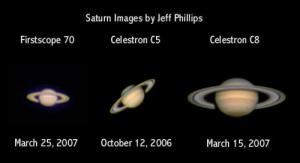It’s been a little while since I did an article. I did a move and bought a new telescope. I decided, after much consideration, to purchases the Celestron 1100 edge HD with the CGEM mount. I was pretty hesitant due to the lack of product reviews and in the astrophotography community you can find helpful individuals but you also find some people who think you have an unlimited budget.
I was kinda surprised at the responses when I laid out my budget and said if you could use this much money what would you get? My initial budget was $5,000 USD. I was referenced over to mounts ranging in the $7,000 – $20,000 range. . .not really helpful and the response is “the mount is the most important thing you need to buy.” This is true. But you don’t need the top of the line if you can’t justify the budget. I did just fine with the $700 6SE standard mount and a crappy home made wedge. That being said lets continue. . .
Like I stated there was a lack of product reviews on the product. most likely because of the cost. there as also little in the way of product reviews on the sites that sold said items. . . most likely the same reason. If you want to save a bit of money and you have patience wait till it goes on sale you can save about $500 and I recommend you buy it from a place that has free shipping. So let me put your mind at ease before you spend about $4,000 on a scope set up.
What should I expect?
Well is this product worth the money you put into it? in my mind yes it was worth every single penny. This thing is a light bucket! but before get into that I want to start at the beginning. I said to try to find a place that offers free shipping. .is it that big of a deal. Oh yes. I had high expectations but I seriously underestimated what i was getting into. This is what shows up at your house :

OK so I got a bit of the phone case over the photo eye. . . .
so It doesn’t look like much but I want to tell you that box on the right with the tube. . its bigger than the freezer on my refrigerator in the house we were living in.
When opening this, don’t destroy the tube of the gears boxes. I personally don’t buy the overpriced cases. what I do is I use the box they were shipped in and keep the foam they were shipped in. if it can survive the UPS guys and a long journey from an overseas factory to the Celestron warehouse, to the wholesaler I bought it from to my house. . .the box it came in sounds pretty good to me.
Take your time and be careful when you open it. It’s packaged pretty good, but there are parts and other small boxes inside when opening it.
Assembly
Go slow read the instructions. I double check that all my fittings are tight and everything is secure before letting go. The scope set up is huge. Unless you are tall, don’t extend the legs fully. I go a little under 1/2 way, this thing gets tall fast!
The instructions are pretty clear an it goes together rather easy. The gearbox is 41 lbs (19 kg). It is capable of a 40 pound payload.
The tube has handles to help get it mounted properly. There isn’t much to say except go slow, practice in the light and give yourself 20-30 min to get set up. The tube is 28 lbs (13 kg) so you have room for some gear.
assembled it should look like this :
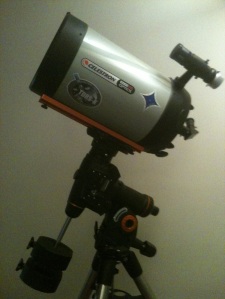
Size is not everything, but I had a great deal of doubt spending more on a scope than I did my car, but you are getting a very solid and substantial piece of equipment. Take this for example, she’s 55 lbs and is average size for Australian Cattle dog :


This is with the legs 40% extended. I went lower because trying to use the view finder. . .even at 5’5″ (1.651 meters) I had to use a chair. I just find it a whole lot easier to just lower it.
What to expect
I know what you are saying. . “ok, I got it it’s big and heavy.” What you are really concerned with is how does it work.
Let’s start with the mount. I have been told by many that you need a far better mount. I’m honestly happy with this one. Once in a while I have issues. I keep forgetting to call I think my clutch is not right but I need to check, I also suspect this may have to do with where i balance the weights on the scope. It has only happened twice, but I want to find out how serious it is, both times it happens when trying to photograph Jupiter. The tracking stops and then it takes off in a direction. very annoying. . . I tried to shut it down and reset the entire system. I also tried to not use the tracking, but it occurred again. I ended up going to a different target and it worked “ok”

As a tip, When using a wedge you have to think opposite from this. you adjust this to read what your latitude is, not your lat minus the pole. I had it backwards the first night and everything was off!
Aside from this happening it runs super smooth and I have had more excellent tracking than bad. I’m extremely happy with the mount. I’m sure the other mounts out there are excellent, but this one seems to work just fine for now.

Optics. . . it’s a light bucket! What I could never see before I can see just fine. Personally I can’t see things like say the lagoon nebula or the whirlpool with my own eyes, I can with the camera. Faint DSO’s like the great Hercules cluster or the ring nebula or the Saturn Nebula I can see directly by looking at it instead of having to do the averted view. Planets seem far more crisp and detailed i didn’t have to strain to see details. I saw far more moons around Jupiter & Saturn and on Mars you could make out dark patches and the polar caps.
I was surprised though when I took the first set of photographs. I thought it was as simple application, perhaps its and maybe I’m in need of changing things up. I haven’t had a clear night in 2 weeks so I can’t try new processes out. I have a few images I can show as comparisons and I can say the photos are far better.
Now first off my last Saturn photo withe good old 6se:

and using a barlow:
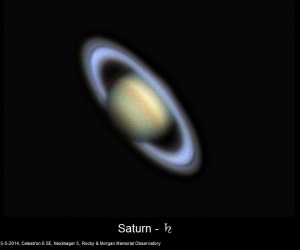
What you will notice the more you try to zoom in with barlows the less detail you get you get more blotchy and pixelated. Using the exact same process I got the following:
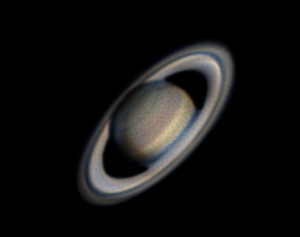

As you can see the bands are much more pronounced. I was not happy with my results as I know I can do better. I found I have to adapt what I am doing and try to change from the old method to a much better new method.
I tried to use Firecapture but I am not too versed in how it works just yet. I like Icap as well. Please note the newer pictures were taken with a new Skyris 236c camera instead of the 3 year old neximager5. Once I get it producing much better photos I’ll do a review on it, but between the two cameras. . what I have been able to produce this is far far better. It has a much higher frame rate. . .but back to the scope.
The new method I talk about is this. in the Old I would record for about 1 and a half minutes of Saturn and then run it all through registax6. Now I record for 2 min and first stack with autostakkert 2. One software I am working on getting the hang of is JUPOS. For DSO’s I broke down and bought nebulosity4. I couldn’t get Deep Sky Staker (DSS) to work properly. It was worth the $100
This is a product review why am I talking processes? Because what used to work on the 6se did not yield very good results on the 100HD. It was very unforgiving for errors. Out of focus, the images make sure you know it when you process them.
another good example of how you can adapt, is I was getting worried about my pictures being complete garbage and that I wasted so much money on a telescope and all along it was just my skills. with learning the new method and better seeing conditions as it went on I got the following results. As a comparison, one of my best mars photos is here from the 6SE :

and

With the 1100 I was able to produce this:
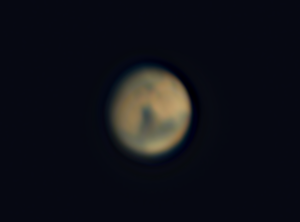
then as I got to applying the new method I got this:
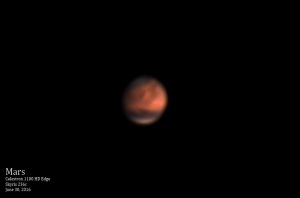
I think if you compare the two you will see there is no doubt it upped my planetary picture capabilities.
How about Deep space objects?
Good Question. I spent so much time with the planets I had barely much time to hit the DSO’s. Fear not though I got a couple and plan on doing more. The current plan is to get more Saturn and Mars pics while I can then on to Uranus and Neptune into the fall, catch Jupiter next winter/spring. In the interim, between classes and Planets I want to get some practice on the DSO’s
Remember how i said I had to learn a new method on planets? Well While I was doing that I looked into what caused my DSO’s to be so grainy looking and rough. This is called Signal to noise ratio. I had been doing what worked when I should have been looking into the right way. I didn’t know because I avoided certain forums due to egos and bad answers. However in the time I started till now there are some tried and tested methods yielding some really good results and I was just . . .out of the loop. That being said, the 1100 is unforgiving on mistakes remember? So I had to learn a new method.
Old method was I would take a bunch of different exposures to get a good result and then I would take the best of those sets and combine a picture manually in photo shop. That’s where Nebulosity helps out. the way to reduce grainy look is to take multiple photos and longer exposures to reduce signal to noise ratio thus increasing your signal and decreasing the grainy look. you take about 20 photos of each set then use Nebulosity to combine them into one image, you get a few tools in the program to help edit the photos.
All of that aside how do DSO’s look? here is the ring nebula from the old 6se:

respectable. . but how does the 1100 stack up? Is it worth the money?
I did a half serious attempt to see if the new method was worth investing time and energy into it. this is my result with said “new method”

While not perfect. it shows the new method combined with the C-1100 has a great amount of potential. A point of note, I used the exact same camera in both of these. as you can also see staking about 10 frames reduced the signal to noise ratio so it is less grainy. I would love to revisit this, make it look a whole lot better. . .this was a half filled effort to see if it was worth it.
How does it stack up to galaxies? Well with the 6se I never got more than the center of Andromeda. the best I ever got was this image of the cigar galaxy :

now to compare I used the Old method and got this of the whirlpool. After this image it was when I looked into the reducing of the signal to noise ratio. I knew there had to be a way. .
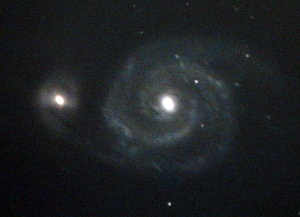
Now all I need are some clear nights. . it’s been raining for the last 3 weeks.
Negatives
It’s heavy. That being aid once set up it is not mobile. . . not one bit. Polar aligning the mount is kinda dreadful at times. It’s not something I would consider portable.
Set up time is greatly increased.
I find with the EQ mount that it has such mobility I sometimes forget to take cameras out and cables and wires get pulled on. so make sure you take them out. you end up moving around the mount quite a bit. try to plan out the viewing to make moving around it easier. Also due to the size and height. I set the height to a good working height where I can get at the finder scope with out a step stool.
Since set up time is increased. . .so is tear down time. . keep that in mind with bad weather.
It is not a scope for amateurs! It is very unforgiving on errors. So its not a negative, but a word that if you aren’t doing that great on your images at first keep at it.
Movement is awkward. . .only until you get used to it. sometimes you have to go 2 directions just to go upward due to target position in the sky. its frustrating and awkward at first but you soon catch on and tart being able to get around.
One major issue I have is the F/6.3 focal reducer I bought with the 6se doe not work on this scope. I cannot get the scope to focus using it. Celestron makes one for the 1100 HD the Reducer Lens .7x – EdgeHD 1100. What really angers me is this is another accessory that is another $600 on average. I am seriously angry at this price tag on something like this. I will be looking into a way to make the other one work or adapt it. It came up as an after thought so they developed one, people got the old one to work on this. I will be posting what I find on it. As for now I am limited to the Orion one for my camera.
Final thoughts
Is it worth the price tag? that depends on if you want to seriously dive into the hobby. If you are worried about the price tag, yes it is expensive. You are getting a sold piece of equipment here! nothing about it is flimsy!
Is it a noticeable difference? VERY much! from visual to photography. I still don’t see certain things with my unaided eye so the camera helps me see these. Even the whirlpool I can’t see with out using the camera.
“What about the mount? I have people telling me its not good enough.” Take it with a grain of salt as the saying goes. so many people get really good pictures with the same set up, and others tell you you have to have the latest and greatest. but I can’t justify spending the same amount on a scope set up as I could for a house.
All in all you will definitely see more and deeper. Your planetary images will look far far better.
My next direction I would like to go is getting the HyperStar and a better camera but Hyperstar first.
I sincerely hope this helps. I had 2 years of agony pouring over each minor details between it and a Ritchey–Chrétien. I was very happy with my choice.
As always keep looking up and never let them tell you you can’t do something!

